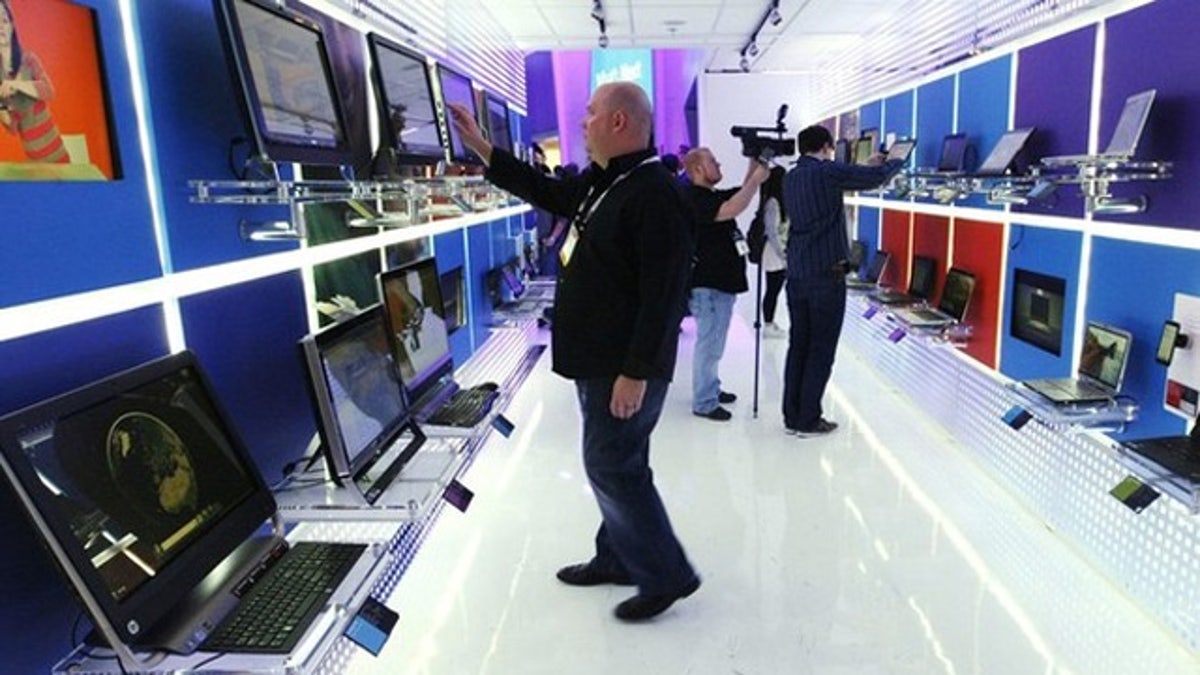
This year's CES has been defined by who didn't show up. (Reuters)
Usually, trade shows are all about playing with prototypes and spotting future trends. But at this year's Consumer Electronics Show, which opened Tuesday in Las Vegas, what's creating the most buzz is what's not there.
Of course, there are thousands of devices being introduced this week in the desert.
Nokia is back with Windows-based smart phones and is vowing to slay the Android giant. There are connected cars and smart refrigerators (yes, again). And computers. Ultra laptops--small, svelte, near-instant-on computers--are being pushed with several manufacturers announcing slick devices.
Samsung will launch its Series 5 Ultra line and Hewlett-Packard, which has apparently stepped back from the PC precipice and decided computers do count, will be offering its Envy 14 Spectre model. Even Lenovo has an ultra laptop.
But what's not at the show are two components that could stifle the ultra yawns: Intel's new mobile processors, which won't appear until the spring, and Microsoft's new Windows 8 operating system with touch features, which wasn't ready in time for a CES debut.
Instead, the big Microsoft news has been that it's abandoning CES. This will be its final appearance at the trade show, and CEO Steve Ballmer's desultory final CES keynote didn't exactly inspire the technorati. The Kinect gesture and voice recognition game controller will now (officially) work with PCs, and Windows 8 will be out later this year, according to Ballmer. The CEO also promised that current Windows 7 PCs will be able to run the new Window 8 software (translation: if it works on existing hardware, it's not much of an upgrade).
Also failing to make an appearance are new gaming console models, updates to Microsoft's Xbox 360, Sony's PlayStation 3, or Nintendo's Wii. Nintendo has promised a new model, and Microsoft and Sony are rumored to be preparing announcements for this summer.
However, it may be too little, too late as televisions continue to offer more features and power--including casual games and online entertainment.
In addition to offering connected services like Netflix, Pandora, and Facebook on living room sets, LG Electronics is bowing a brand new, incredibly sharp and stunningly thin 55-inch TV that uses Organic Light Emitting Diode or OLED technology. It will be available in the fall, and the sets represent a major improvement over LCD TVs. But what is attracting more attention is the addition of limited voice recognition technology. New LG remote controls will include a microphone so that viewers can surf the Web using spoken words (you can't change the channel by yelling at the TV yet, however).
Taking another feature from the likes of Kinect and the game consoles, Samsung has added built-in video cameras to a new line of TVs so that its models will recognize faces and gestures (as well as voice commands) and automatically adjust the set according to personal preferences. It will also, no doubt, make video calls that much easier, all thanks to the television's new dual-core processors. In effect, that completes the transition of televisions from dumb displays to giant, intelligent living room computers.
This fact has not escaped the notice of two of the biggest tech players, Google and Apple.
Google has finally spiffed up its Google TV software (which is based on the mobile Android platform). And it looks like it may finally begin expanding its roster of hardware partners.
Sony continues to support Google TV and now LG will offer models with the software, which is now also being touted as a gaming platform. LG plans to continue to offer its own "smart" features alongside Google's apps, an option that may encourage other manufacturers to include Google TV later this year. It also marks yet one more step toward the elimination of the ancient cable company set top box, but don't expect that to happen any time soon. Last year at CES, for example, Sony announced a TV that would work with Time Warner Cable with out a box, but the set never materialized.
Still, what's on many minds is Apple TV. No, not the set top box that's been little more than a curiosity in the market, but rather a full-sized HDTV with a fruit logo under the screen. Rumor mills have burgeoned into rumor factories on the topic, but Apple does not participate in CES. If there is going to be an Apple HDTV this year, fans will have to wait for any official announcement.
So if the biggest news is about products that aren't ready yet or aren't at the show, does that mean that the CES is party is over? Probably not. The show has gobbled up the photography exhibit and added white goods -- industry argot for kitchen appliances.
So maybe next year we'll be lusting after stoves and dishwashers -- or wondering when the new Apple refrigerator will be announced.
Follow John R. Quain on Twitter @jqontech or find more tech coverage at J-Q.com.
